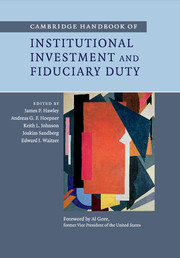Book contents
- Frontmatter
- Contents
- List of figures
- List of tables
- List of contributors
- Foreword
- 1 Introduction
- Part I Fiduciary duty: a global outlook
- Part II Fiduciary duty and the landscape of institutional investment
- Part III Challenging conventional wisdom on fiduciary duty
- Part IV Towards a broader interpretation of fiduciary duty
- 20 Fiduciary duty and the search for a shared conception of sustainable investment
- 21 Pension fund fiduciary duty and its impacts on sustainable investing
- 22 Reason, rationality and fiduciary duty
- 23 Socially responsible investment and the conceptual limits of fiduciary duty
- 24 Fiduciary duty at the intersection of business and society
- 25 Challenging conventional wisdom: the role of investment tools, investment beliefs and industry conventions in changing our interpretation of fiduciary duty
- Part V Beneficiaries’ roles and viewpoints
- Part VI Fiduciary duty and governance
- Index
- References
23 - Socially responsible investment and the conceptual limits of fiduciary duty
Published online by Cambridge University Press: 05 April 2014
- Frontmatter
- Contents
- List of figures
- List of tables
- List of contributors
- Foreword
- 1 Introduction
- Part I Fiduciary duty: a global outlook
- Part II Fiduciary duty and the landscape of institutional investment
- Part III Challenging conventional wisdom on fiduciary duty
- Part IV Towards a broader interpretation of fiduciary duty
- 20 Fiduciary duty and the search for a shared conception of sustainable investment
- 21 Pension fund fiduciary duty and its impacts on sustainable investing
- 22 Reason, rationality and fiduciary duty
- 23 Socially responsible investment and the conceptual limits of fiduciary duty
- 24 Fiduciary duty at the intersection of business and society
- 25 Challenging conventional wisdom: the role of investment tools, investment beliefs and industry conventions in changing our interpretation of fiduciary duty
- Part V Beneficiaries’ roles and viewpoints
- Part VI Fiduciary duty and governance
- Index
- References
Summary
Introduction
Socially responsible investment (SRI) can be defined as the practice of integrating putatively social, ethical and/or environmental considerations into one’s financial investment process. Whereas conventional or mainstream investment focuses solely upon financial risk and return, SRI also includes social or environmental goals or constraints in decisions over whether to, for example, acquire, hold or dispose of a particular investment. This practice has received increased attention over the last couple of decades (Eurosif 2010; Social Investment Forum 2010). However, the factor that many commentators think will determine whether it can grow further in the future is whether SRI is a viable form of investment for large-scale institutional investors like pension funds (Kiernan 2002; Sparkes and Cowton 2004).
Pension funds are basically enormous pools of money, invested in a wide array of shares and bonds on the stock market with the ultimate aim of providing retirement income for future pensioners. These funds have become the dominant players on the world’s financial markets over the past fifty years or so. For instance, global pension assets are estimated to be worth some $24 trillion (IFSL 2009). Quite obviously, if a lot of pension funds could be persuaded to invest according to social and environmental guidelines, the SRI movement could become an important force for corporate social responsibility worldwide. But in what manner or for what reason could they be persuaded to do so – that is, how could one justify pension funds’ engagement in SRI?
- Type
- Chapter
- Information
- Publisher: Cambridge University PressPrint publication year: 2014
References
- 1
- Cited by

